Consolidated Catalina II, Leitrim, March 1941
On the 21st March, 1941, seven airmen of the Royal Air Force
and one from the Royal Canadian Air Force took off on their very
first patrol mission from their new base on Lough Erne.
They had arrived on the Lough only the day before but sadly
would never return to its waters. Their new Consolidated
Catalina Flying boat crashed into a hill side in the Kinlough
Valley in Leitrim killing all eight.
.
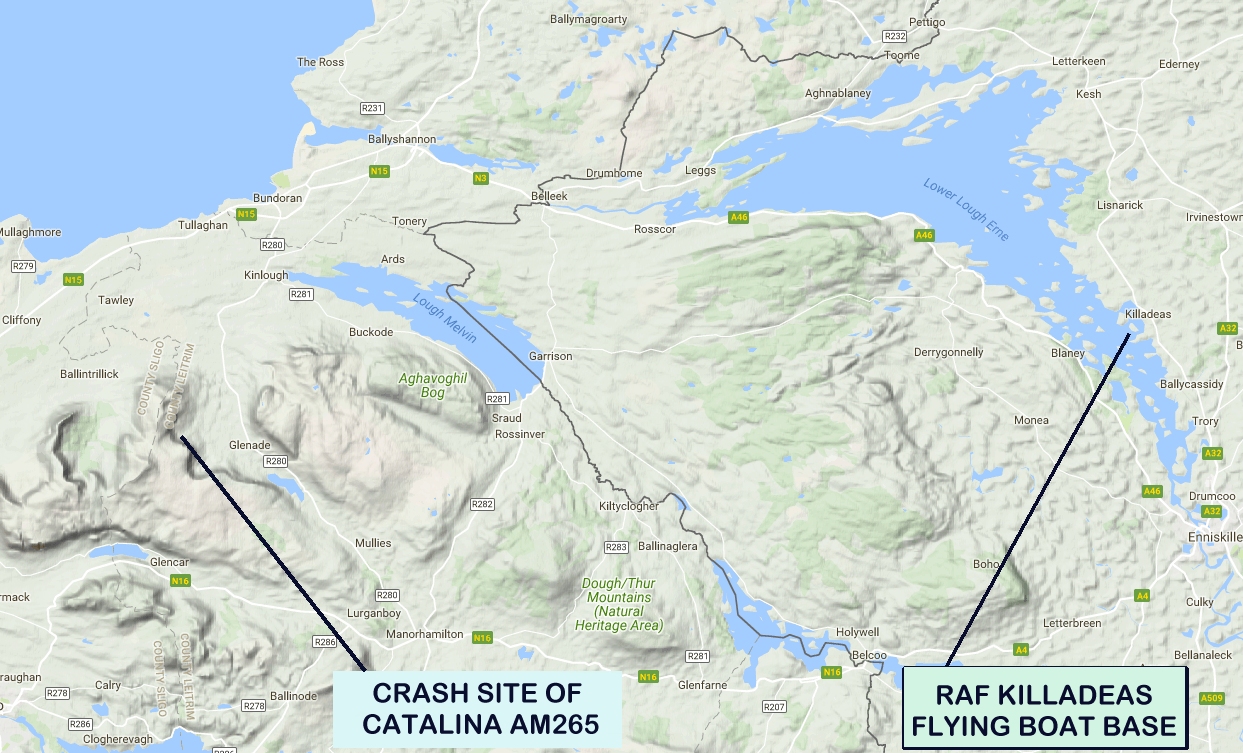
Extensive reports by a number of Irish Army officers provide
back ground to what Irish Authorities found at that crash site
on that morning.
"The aircraft had apparently hit a
bank at the base of a very steep hill. After bouncing
off this bank it had come to rest facing the direction from
which it had come. The engines were buried in the
ground about 15 feet from the fuselage. The visibility
there on the morning of the crash was very bad, the
mountains on the borders of Leitrim, Sligo and Donegal being
covered with heavy fog."
A local man, and member of the Local Defense Force (LDF), gave
a statement to the army officers on the scene on the day of the
crash:
Statement of PATRICK MCGLONE
of Prucklish, member of B Groupe L.D.F. Glenade
district.
21-3-41.
“About 7.25 a.m. I heard a plane coming from the
East and going West; again at 7.40, a plane came over
my house flying very low, also going East to
west, zigzaging and seemingly out of order. About five
minutes later, I saw it crash at the foot of Aunagh
Hill and I heard a loud explosion followed by several
smaller explosions which lasted for about half an
hour. I then made my way to where I saw the plane had
crashed after the explosions had ceased to see if any of the
crew were alive or could be saved, but all the bodies were
burned or charred beyond recognition. As soon as I heard the
loud explosion, I sent my son Patrick Michael to notify the
Kinlough Guards; this was about 7.45 a.m.
I heard another plane circling around the same locality
about 11 a.m.
(Signed) Patrick McGlone
Proughlish
Largydonnell P.O.
Of the eight men killed, Whitworth, Davidson, Chalk, Dunbar,
Oldfield and Slack were all buried in Irvinestown Church
of Ireland Churchyeard while Harry Newbury was buried in the
nearby Irvinestown Roman Catholic cemetery.
Only Harold Seward's remains were returned to his family for
burial in Apuldram, outside Chichester, Sussex.
The local Irish registrar was able to record the deaths of
Whitworth, Slack, Newbury and Seward, with the remaining four
men entered on the death register as 'unidentified' airmen of
the RAF.
The Squadron operations Record Book is rather sparse in names
for the months prior to the crash. Operational missions
are recorded with only the two pilots names. On the 13th
February 1941, it is noted in the ORB that P/O Harding and F.Lt
T A W Edwards proceeded with eleven airmen to Lough Erne to
establish an advanced based. The first of the Stranraers
from 240 Squadron proceeded there on the 20th February and
flights were carried out on the 24th February searching for
mooring sites. Beginning in March there is mention of the
appearance of Catalina's at the squadron, with 15th March being
the first observed mention of the ill fated AM265. On that date,
its compass was swung in Stranraer.
The names of non commissioned aircrew are rarely mentioned
within the ORB unless they were unfortunate enough to be lost on
a mission.
On the 20th March W/Cmd Watt and P/O Seward, F/O's Louw and
Whitworth, and P/O Davidson proceeded to Lough Erne. It is
not clearly stated but this would seem to be inferring that
three crews flew their aircraft to the new base in Northern
Ireland.
The following day of course would see Seward, Whitworth and
Davidson board AM265 with another two crews on two more
Catalina's. Only two of these would return from that
mission, and one of those had to land at RAF Bowmore.
The early RAF Form 765 filed for this crash and now found in
the AIR81 casualty pack only states that there was poor weather
at the time of the crash.
The location of the crash site is marked with a memorial plaque
raised by the Lough Erne Aviation Museum in 1988. That
organization no longer exists it seems but at the time of
writing in 2020, a number of individuals continue to maintain
the memorial.
The crash site is found not at the base of the large cliffs but
on a piece of rising ground just at their base and not to far
distant from a distinctive outcrop of rock. This location
places it within the townland of Cleighragh which
borders on the "Eagles
Rock" car park.
Please note, that the crash site may be on private land and
one has to cross fields to get to it so please bear this
in mind if you decide to visit. Permission of the
land owner should be obtained.
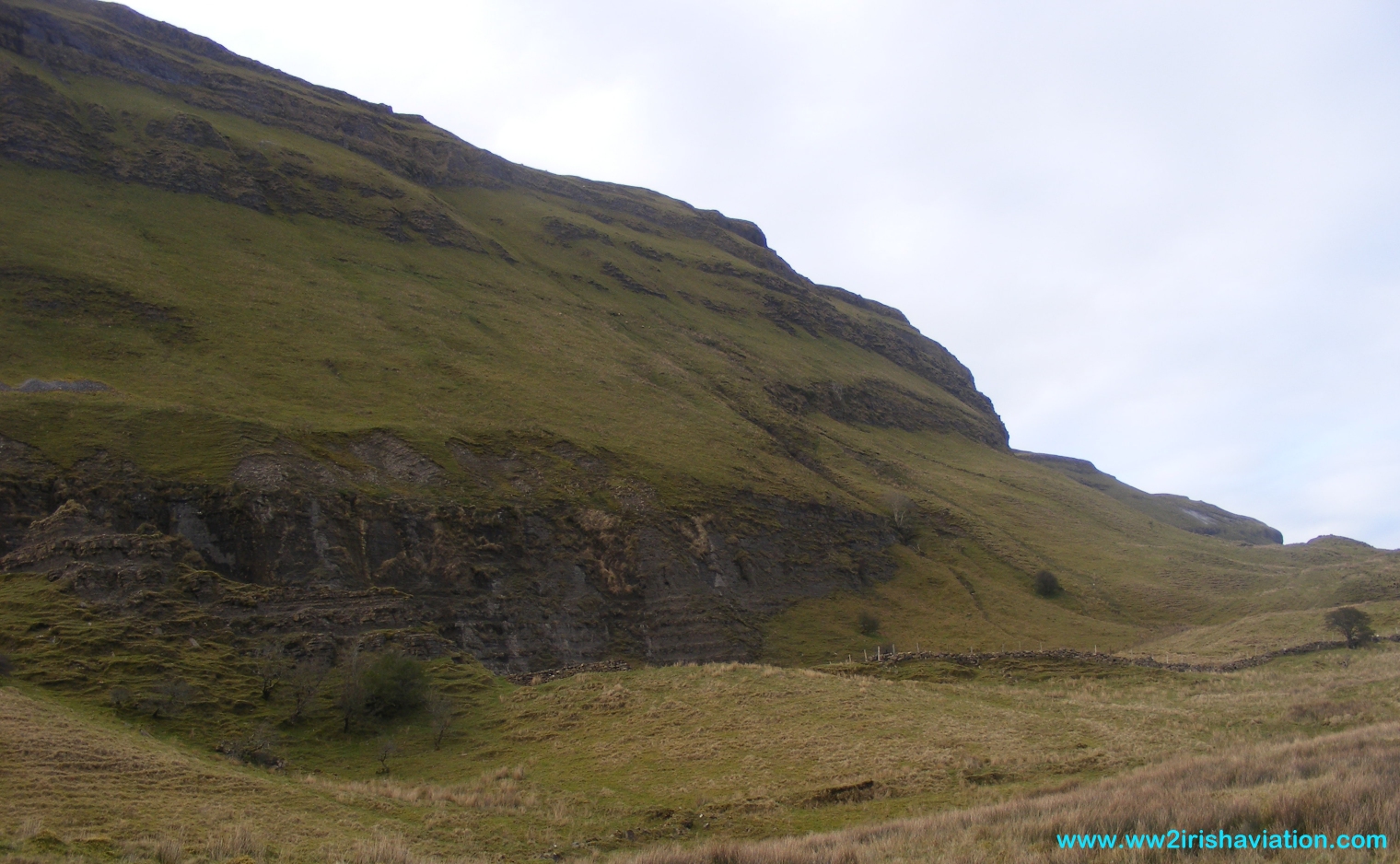
Zooming in on the fence line in the middle right of the image
above, one can see the memorial cross poking above the fence.
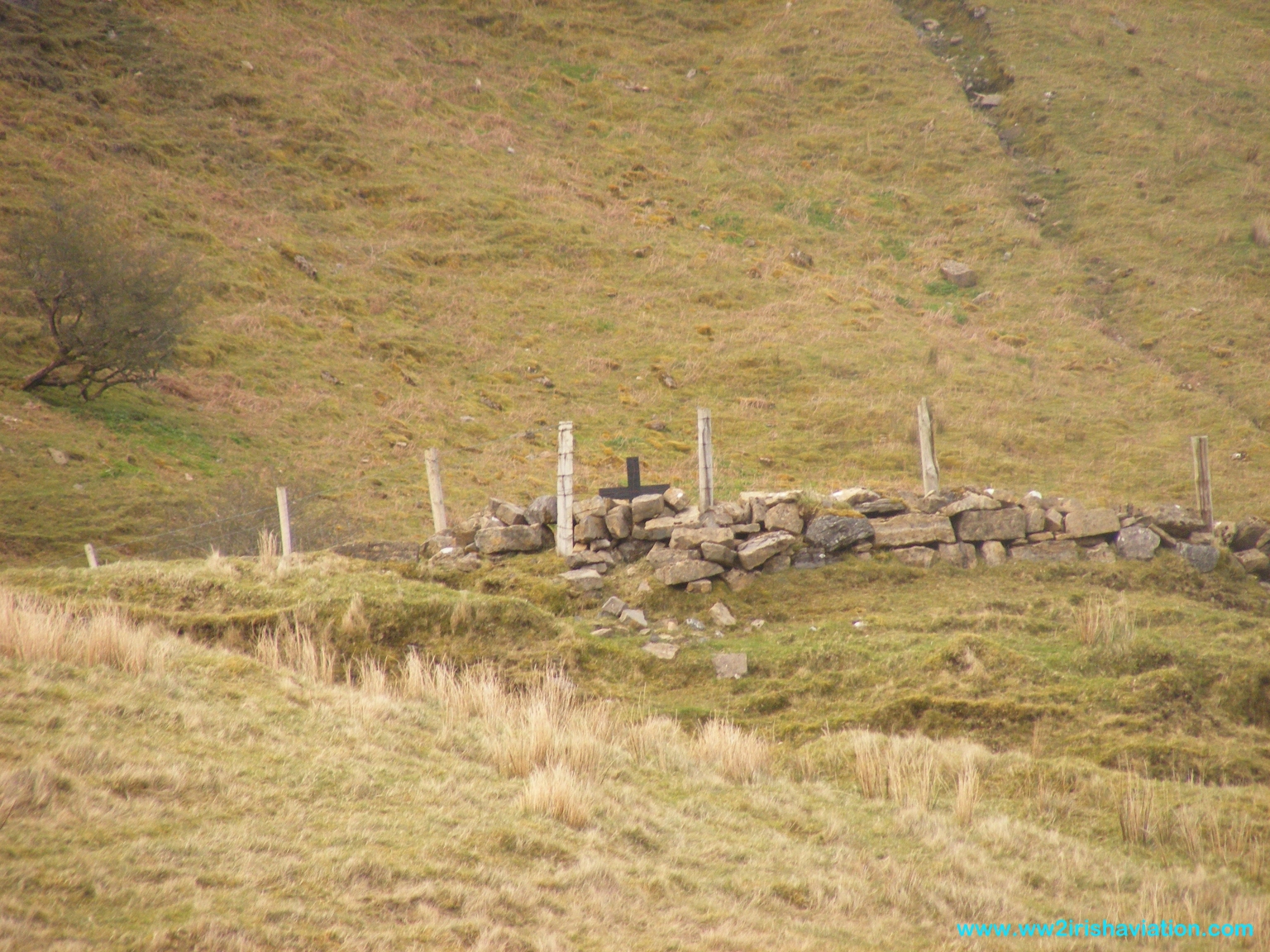
This image provided by a relative of one of the airmen shows
the proximity to the rocky outcrop.
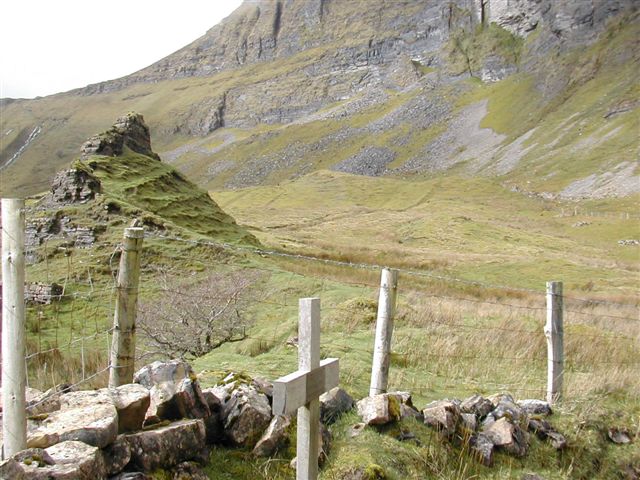
This image below, taken at the memorial, looks back towards the
road from where I walked, and you can see a little of Glenade
Lough in the middle left and the beautiful rock column at Eagles
Rock or Clontypruglish.
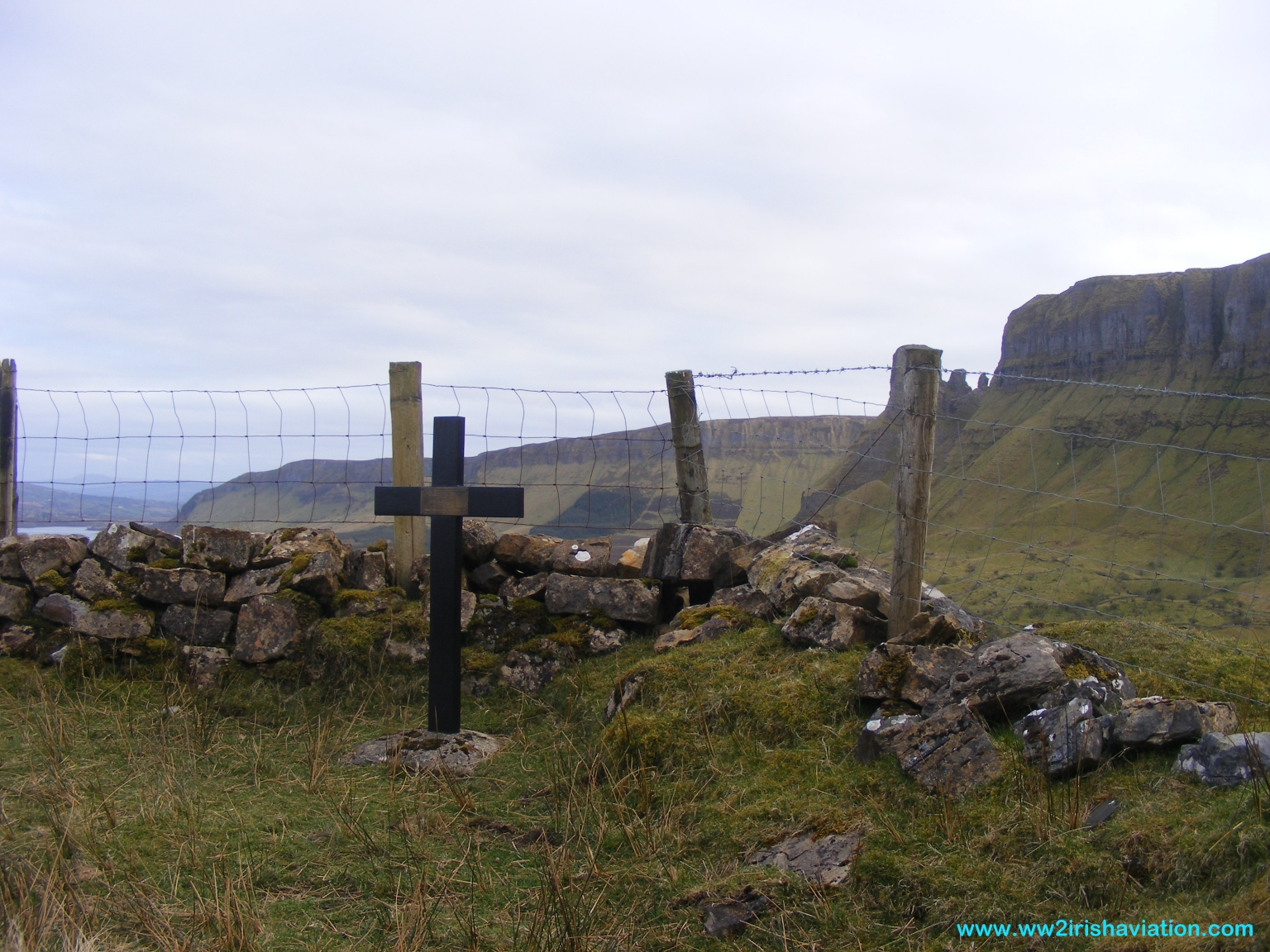
The following two images show the traces of metal and debris at
the site, which had recently been disturbed during a visit of a
relative of one of the men. The fragments are little more
than blobs of melted aluminum, testament to the fire that
occurred.
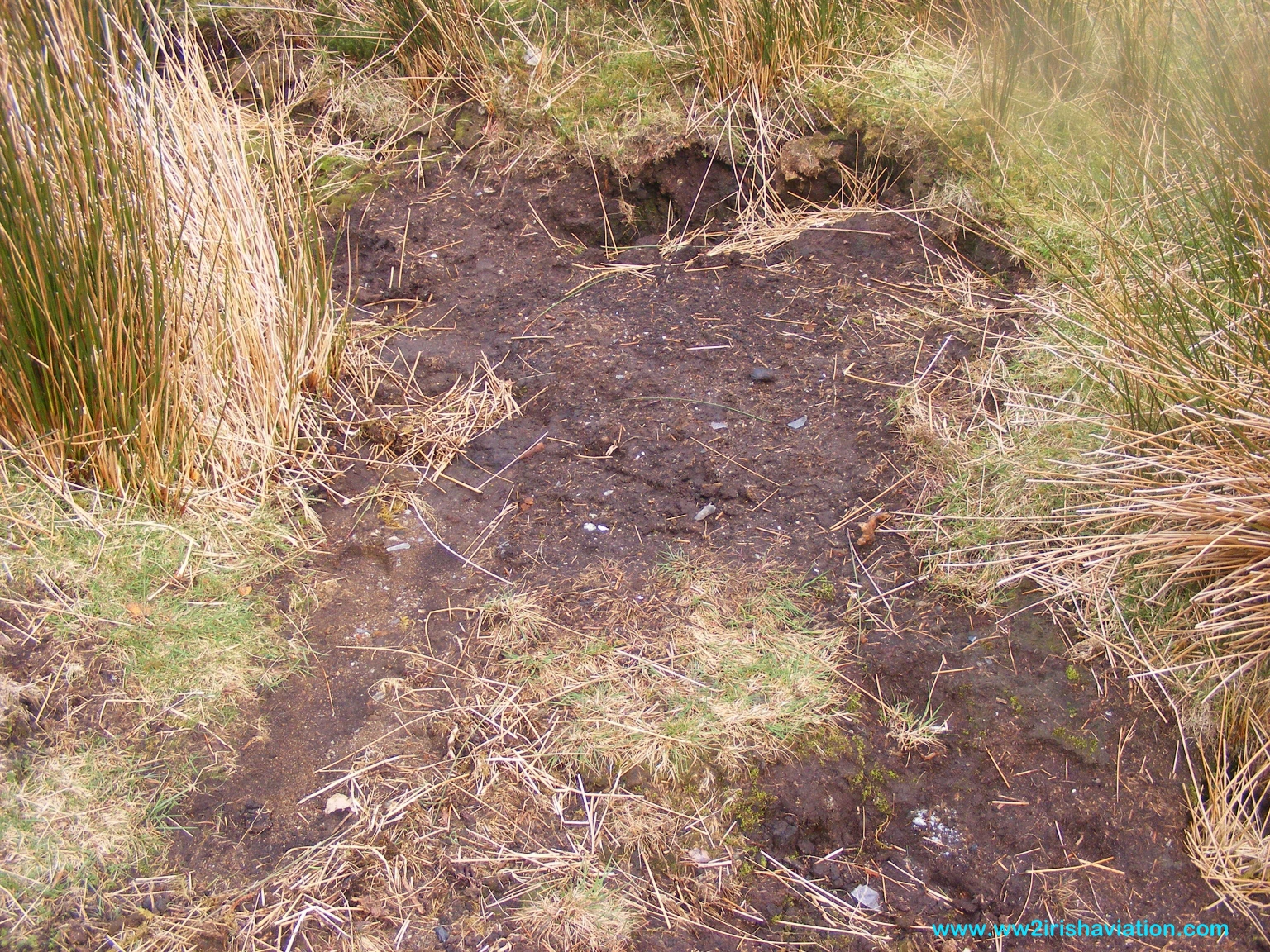
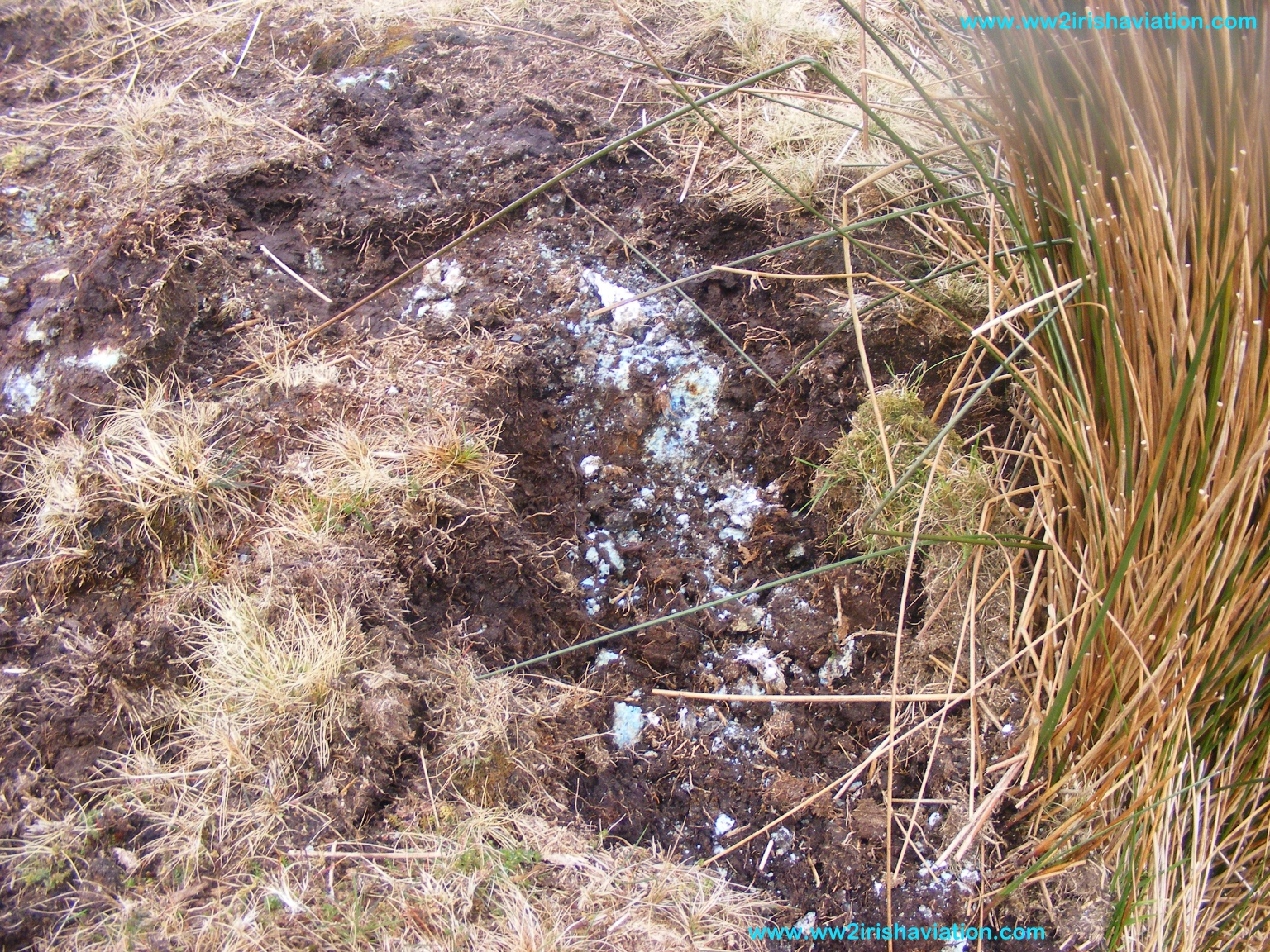
The inscription on the memorial cross is shown below:
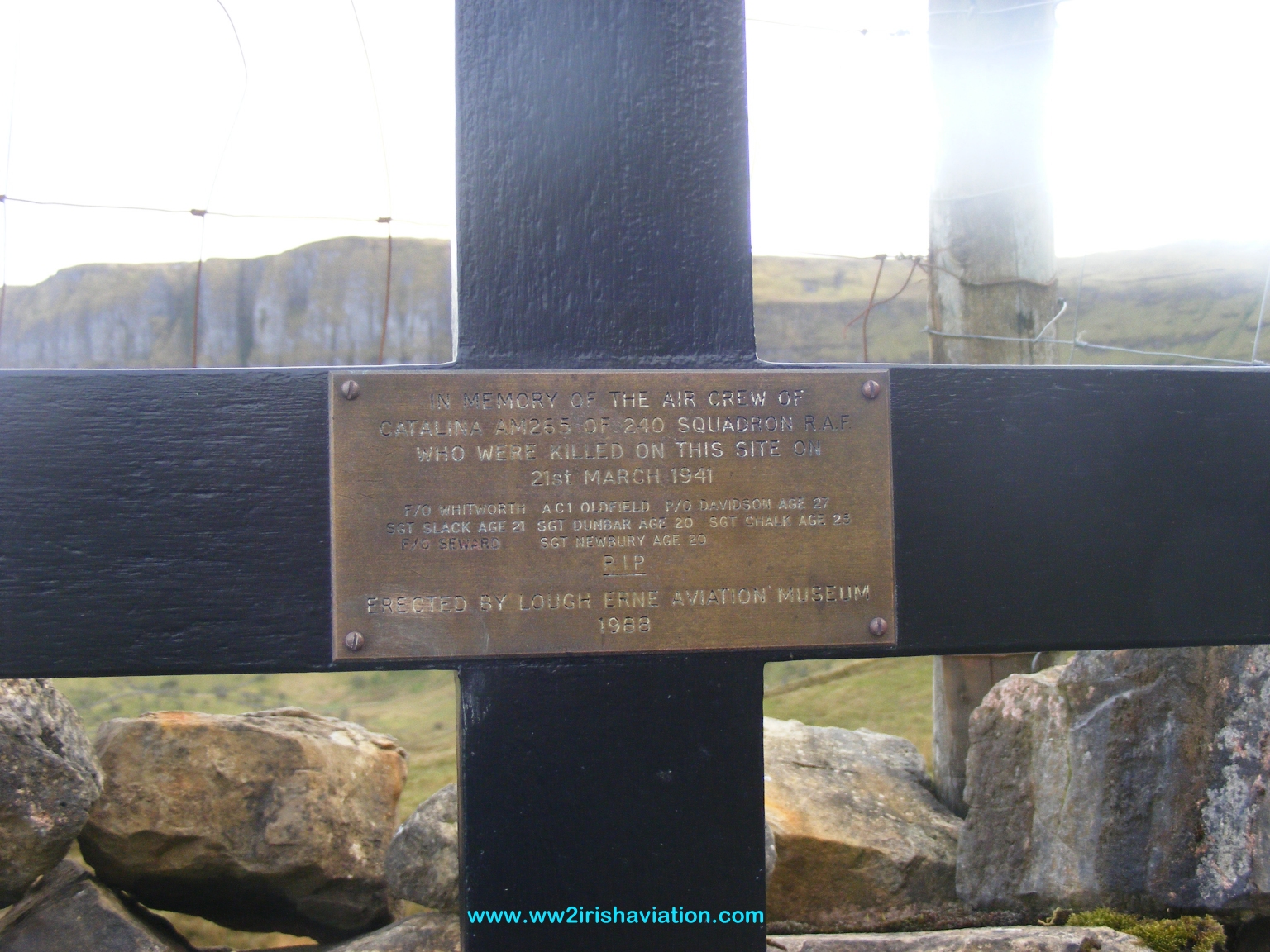
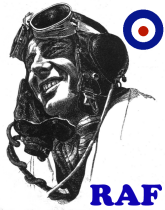 F/O Albert Edmond Whitworth 33555 appears
in the 240 Squadron ORB for 1941 on 3rd January, flying a patrol
in Stranraer K7298 as co-pilot, flying almost 4 hours for a
convoy that never sailed. He fly's again with F/O Louw on
Jan 6th, 7th, 10th, 13th, 14th, 17th, 19th, 24th, 29th, 30th,
31st, Feb 7th, 9th, 10th, 12th, 13th, 14th, 16th. On the
3rd of February is was recorded by the Squadron that he had
completed completed night training on the Stranraer. He
co-piloted a Stranraer to Greenock with F/O Louw on 19th
February, and was back on the 22 Feb to allow him go on leave
the following day. On the 6th of March he was part of a
crew that delivered Catalina AM267 to the base at
Stranraer. He was born in Manchester in May 1920. At
the start of his RAF career, Flight magazine printed in march
1939: "Viscount Wakefield"
scholarships, at the Royal Air Force College, of the value
of £75 each, have been awarded to Fit. Cadet R. H. Clifford,
and to Fit. Cadet A. E. Whitworth, an open competition
entrant.
F/O Albert Edmond Whitworth 33555 appears
in the 240 Squadron ORB for 1941 on 3rd January, flying a patrol
in Stranraer K7298 as co-pilot, flying almost 4 hours for a
convoy that never sailed. He fly's again with F/O Louw on
Jan 6th, 7th, 10th, 13th, 14th, 17th, 19th, 24th, 29th, 30th,
31st, Feb 7th, 9th, 10th, 12th, 13th, 14th, 16th. On the
3rd of February is was recorded by the Squadron that he had
completed completed night training on the Stranraer. He
co-piloted a Stranraer to Greenock with F/O Louw on 19th
February, and was back on the 22 Feb to allow him go on leave
the following day. On the 6th of March he was part of a
crew that delivered Catalina AM267 to the base at
Stranraer. He was born in Manchester in May 1920. At
the start of his RAF career, Flight magazine printed in march
1939: "Viscount Wakefield"
scholarships, at the Royal Air Force College, of the value
of £75 each, have been awarded to Fit. Cadet R. H. Clifford,
and to Fit. Cadet A. E. Whitworth, an open competition
entrant.
His local newspaper, recorded his death with the following
short note:
PILOT IS KILLED Flying-Officer A. E.
Whitworth, son of the late Mr. G. H. Whitworth, Parkhills,
Bury, and of Mrs. Whitworth, of Glasgow, has been killed on
active service at the age of 20. Flying-Officer Whitworth
was educated at Bury Secondary School and Cranwell.
His father had died in 1933, and at the time of his death his
mother lived at 182 Whitehill St, Glasgow. For this reason
he appears on the Scottish National War Memorial. He was
survived also by a brother named James Kay Whitworth.
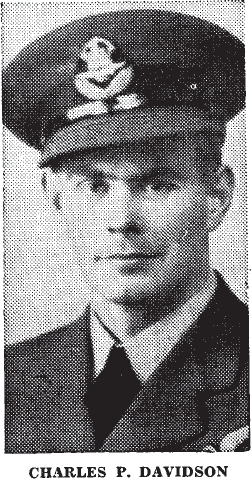 P/O Charles Peers
Davidson J/3113 of the Royal Canadian Air Force, is noted,
without initials or mention of being RCAF, as being posted into
the Squadron at Stranraer on January 8th from Uxbridge. He
was in the base hospital for a number of days, returning on the
1st of February. On the 12th March, it appears that he
accompanied F/O Louw of the Squadron to Greenock and they
brought Catalina AM268 to Stranraer.
P/O Charles Peers
Davidson J/3113 of the Royal Canadian Air Force, is noted,
without initials or mention of being RCAF, as being posted into
the Squadron at Stranraer on January 8th from Uxbridge. He
was in the base hospital for a number of days, returning on the
1st of February. On the 12th March, it appears that he
accompanied F/O Louw of the Squadron to Greenock and they
brought Catalina AM268 to Stranraer.
Charles was the son of Campbell and Mary Davidson, who were
living in Vancouver at the time of his death. Charles was
born there in August 1913. He finished his schooling and
education in 1935 with a Commerce Degree and worked for a time a
number of companies up to August 1939 when he moved to Montreal
and decided he wished to join the RCAF. This he achieved
in May of 1940. Like many he wanted to be a pilot was
instead put through observer training to become a
navigator. Throughout 1940 he progressed through Air
Observer School, Bombing and Gunnery School and Air Navigation
School, being awarded his Air Observers Badge in October.
His service file is not very detailed but he had only arrived
in the UK in December 1940.
His uncle was written to in May 1941 by the RCAF noting that he
had died in 'Pruglish' near Kinlough at approximately 8.10 am on
the 21st of March 1941.
The following article was published in newspapers on 24 March
1941 in Canada.
A cable has been received from the
Under Secretary of State Air Ministry, Whitehall, London, by
Mrs. Campbell Davidson of 1266 West 13th Ave. informing her
that her only son, Flying Officer Charles Peers Davidson has
lost his life as the result of air operations on March 21,
1941.
Flying Officer Peers Davidson was the only son of Mrs.
Davidson and the late Dr. Campbell Davidson of Qualicum
Beach, and grandson of the late Hon. Sir Charles Peers and
Lady Davidson of Montreal, and the late Rev. Cannon and Mrs.
Motherwell of the Diocese of Niagara.
Flying Officer Davidson was 27 years of age and was
well known in Vancouver and on the Island. His early
education was received at Shawnigan Lake School following
which he attended the University of B. C. graduating in
Commerce in 1935.
He was a member of the Zeta Psi fraternity. Flying
Officer Davidson joined the R.C.A.F. at Vancouver in May,
1940, was trained as an observer, passing sixth out of his
class of 60, and arrived in England only three months ago.
He is survived by his mother, Mrs. Campbell Davidson and his
twin sister, Mrs. Gordon K. Noble of Vancouver.
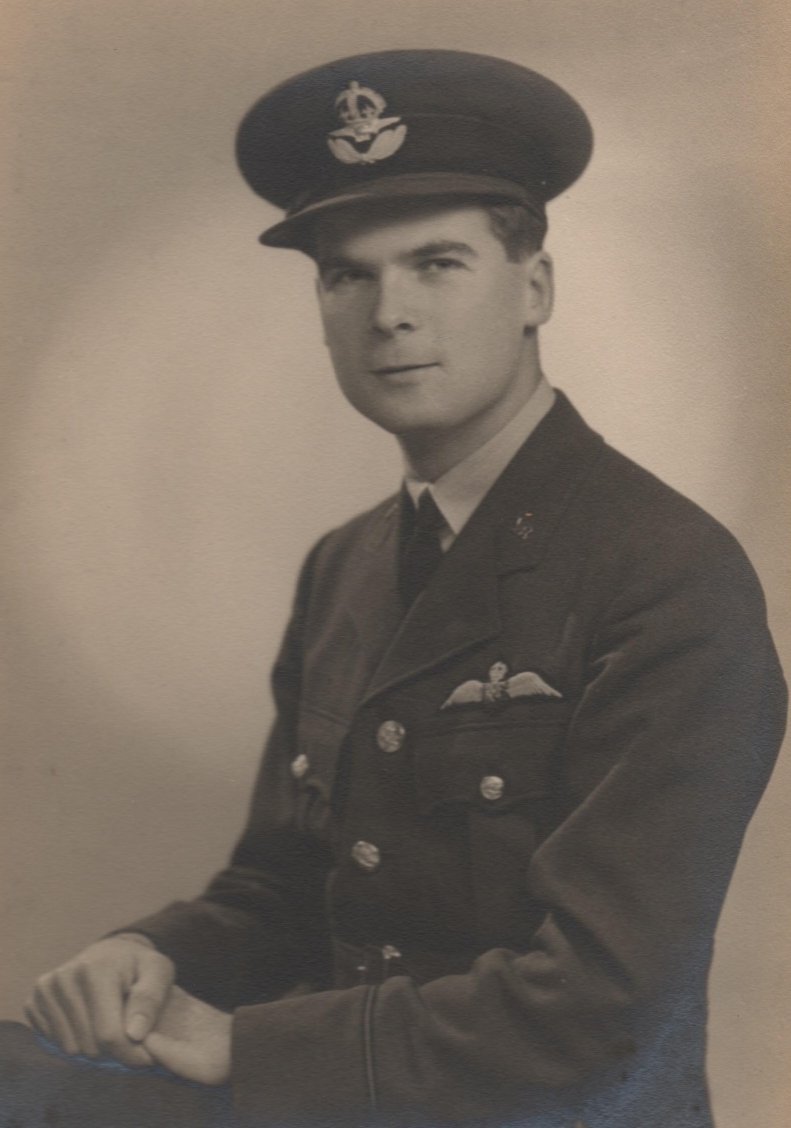 P/O
Harold Lewis Seward 84330 was recorded on the Squadron as
having been posted in from the FBTS (Flying boat Training
School) on January 25th, 1941. He was posted on leave on
the 7th of February 1941`but was back on the unit by 21st
February when he is noted as as proceeding to Lough Erne with
"secret documents". Harold was the son of Percy Harold and
Frances Amelia Seward from Birdham Road in the Chichester.
P/O
Harold Lewis Seward 84330 was recorded on the Squadron as
having been posted in from the FBTS (Flying boat Training
School) on January 25th, 1941. He was posted on leave on
the 7th of February 1941`but was back on the unit by 21st
February when he is noted as as proceeding to Lough Erne with
"secret documents". Harold was the son of Percy Harold and
Frances Amelia Seward from Birdham Road in the Chichester.
A local newspaper on the carried the following short notice in
March 1941.
"Mrs and Mrs P Seward, of Southlands,
Birdham Road, Chichester, have received notification from
the Air Ministry that their son, Pilot Officer Harold Lewis
Seward, has been killed on active service.
The following obituary was printed on the 3rd of April 1941 in
the Sussex Gazette and South of England Advertiser:
THE LATE PILOT-OFFICER H. L. SEWARD
Full service honours were rendered at the funeral at
Appledram last Wednesday of Pilot-Officer H. L. Seward, of
Southlands, Birdham-road, who was killed in a crash in
Northern Ireland. By a sad coincidence, he was on the
point of celebrating his 21st birthday. As an old boy
of Chichester High School he left a fine record there in
scholarship and sport. While engaged with the National
Provincial Bank in Southsea after leaving school he
volunteered for flying duties with the Volunteer Reserve at
Portsmouth before the war, and was granted a commission
about a year ago. The coffin was carried to the
churchyard by R.A.F. bearers with an escort, and with the
covering Union Jack was laid the dead officers forage
cap. The Archdeacon of Chichester conducted the
service with Rev. H. Watson, rector of St. Pancras.
Pilot Officer Seward before volunteering for flying duties with
the R.A.F. was on the staff of the Palmerston Road branch,
Southsea, National Provincial Bank. He would have been 21
yesterday."
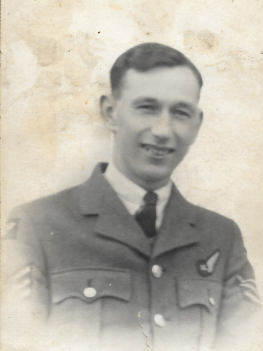 Sgt Frederick
Rodney Albert CHALK 534048 was the son of Joseph Hiram and
Alice Louisa Chalk, of 18 Prospect Place, Haverfordwest,
Pembrokeshire and the husband of Doreen Mildred Chalk.
They had married just weeks before the crash, on 27th February
1941 in Llamflom, Wales.
Sgt Frederick
Rodney Albert CHALK 534048 was the son of Joseph Hiram and
Alice Louisa Chalk, of 18 Prospect Place, Haverfordwest,
Pembrokeshire and the husband of Doreen Mildred Chalk.
They had married just weeks before the crash, on 27th February
1941 in Llamflom, Wales.
Frederick was a prewar member of the RAF having joined up in
August 1936 as an aircraft hand, and first serving as an
Aircrafthand Mate. His first postings were to 107 Squadron
and then No 3 Wing before joining 240 Squadron in March 1939.
He is listed as a crew member on 19 Dec 1939 on London K5258 when they encountered a He111 bomber and the aircraft engaged them in combat. Frederick's pilot was killed that day during the engagement.
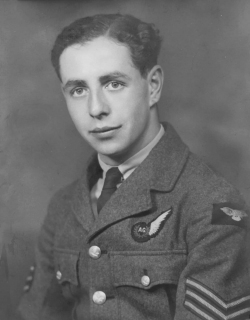 Henry Dunbar,
son of David and Edith Dunbar, lived at Molesden Hough, Mitford,
Northumberland. He was born in Sunderland in February
1921. His nephew visited Irvinestown in March 2019 and
then traveled to Leitrim to visit the area of the crash.
He was very kindly able to provide a number of photos of his
uncle Henry.
Henry Dunbar,
son of David and Edith Dunbar, lived at Molesden Hough, Mitford,
Northumberland. He was born in Sunderland in February
1921. His nephew visited Irvinestown in March 2019 and
then traveled to Leitrim to visit the area of the crash.
He was very kindly able to provide a number of photos of his
uncle Henry.
The image below shows Henry standing on the rear fuselage of a
Supermarine Stranraer flying boat, the type used by 240 Squadron
in the months just prior to the arrival of the Catalina
aircraft.
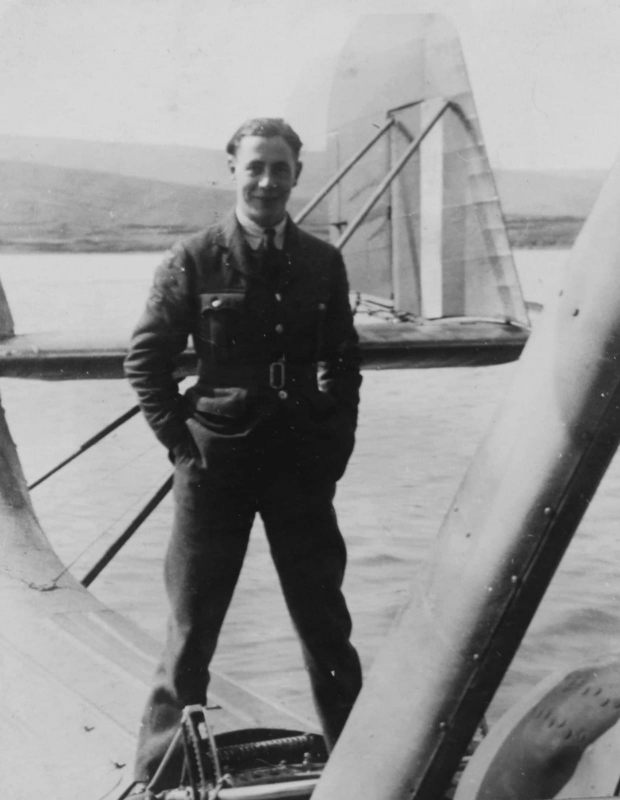
The image below shows Henry Dunbar behind three of his
comrades. Some of them may be members of the fatal AM265
crew, but at this time, it cannot be confirmed. They are
seated on a Saro London flying boat, going by the arrangement of
struts behind them, a type operated 240 Squadron in 1939-1940.

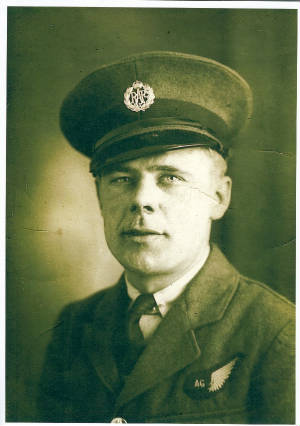 AC1 Ronald
Henry OLDFIELD 940612 was the son of Father Henry William
Oldfield, Mother Dorothy Mildred Oldfield (nee Young) residing
Acton,Middlesex and was born on 21 Nov 1917. Ronald
served as a Special Constable prior to joining the R.A.F."
AC1 Ronald
Henry OLDFIELD 940612 was the son of Father Henry William
Oldfield, Mother Dorothy Mildred Oldfield (nee Young) residing
Acton,Middlesex and was born on 21 Nov 1917. Ronald
served as a Special Constable prior to joining the R.A.F."
Ronald was a Fitter Mechanic (A) on the aircraft and may not
normally have been a member of air crew. Around this time
the RAF had began to only allow aircrew hold the rank of
Sergeant or higher. Among the notes in the AIR81 file in
the UK National Archives, it is minuted that Ronald had be
promoted to the acting rank of Temporary Sergeant during 1940.
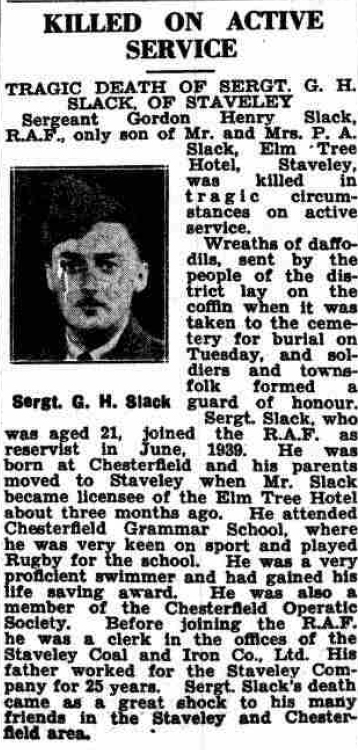
Sgt Gordon Henry SLACK 754693 was the son of Philip
Arthur and Mabel Browne Slack of Elm Tree Hotel, Staveley near
Chesterfield, Yorkshire. He was born in June 1919 and at
the time of the 1939 register, his name is entered with no
occupation listed but does list him as "RAF
Sergeant 75469", the last digit of the number
missing due to redaction on the page. At that time, the
family were residing at Saltergate in Chesterfield. He
does not appear to have any siblings.
Gordon was an airgunner on the crew of AM265.
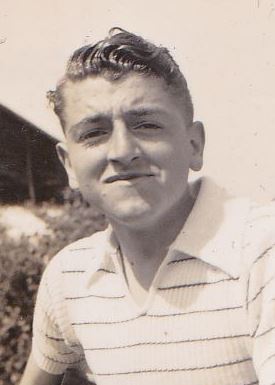
Sgt Harry Harley NEWBURY 624214 +
In early March 2020, during the COVID19 pandemic, three young
boys and their father very kindly visited various spots in the
area to find and document wreckage of Catalina AM265. The
McCabes, James, Oscar and Myles very kindly shared their
exploits with the website, and their photos can be seen below.
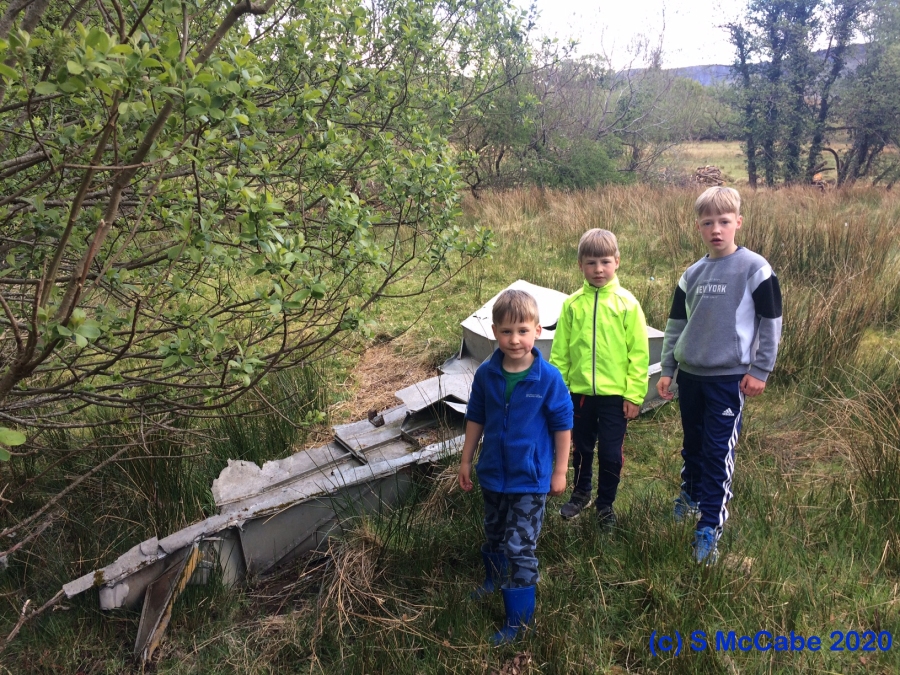
The boys are seen above with a large section of wreckage that
at first glance might not be identifiable except that it came
from very recognisable part of the Catalina's vast wing, namely
the recess at the wing tip for the folding wing tip floats. That
area is very evident in this snippet from a diagram of the
wing. The trapazoidal area filling the gap in the float
support strut.
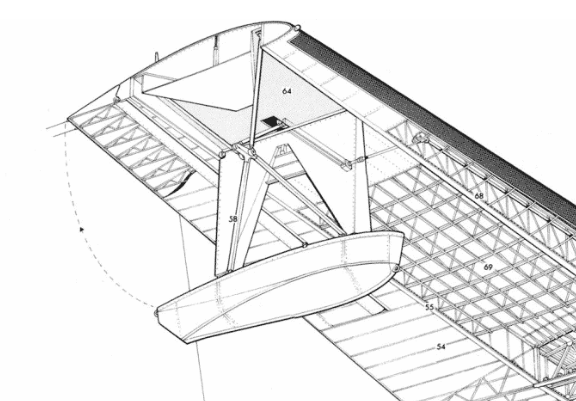
The three photos below show the section in detail and allow for
a good comparison with the diagram. This section of
wreckage lies a good distance from the crash site, across the
nearby road and is visible on satellite photos due to its bright
colour lying in the grass of a farmers field.
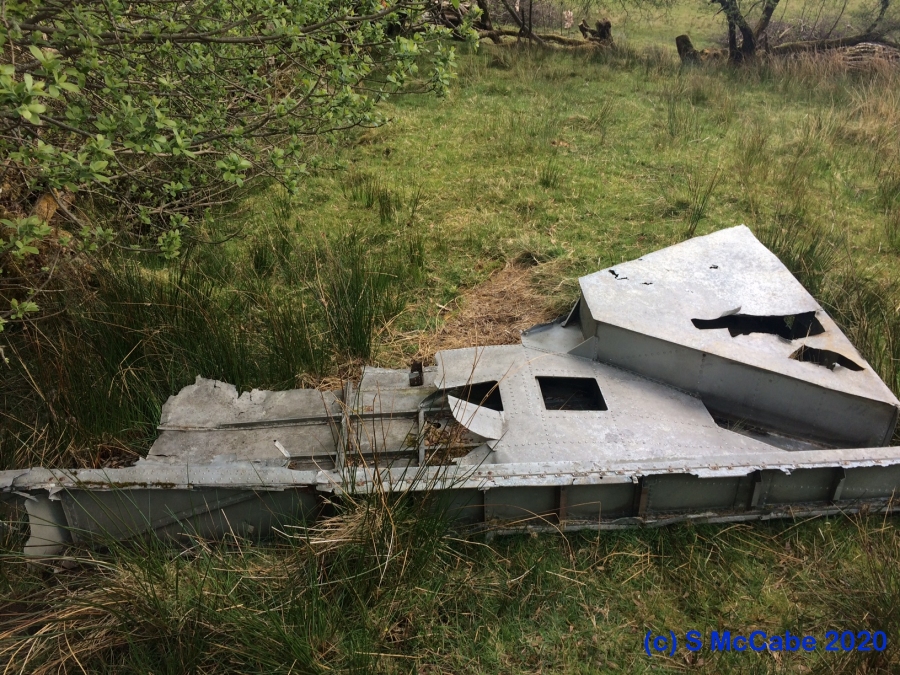
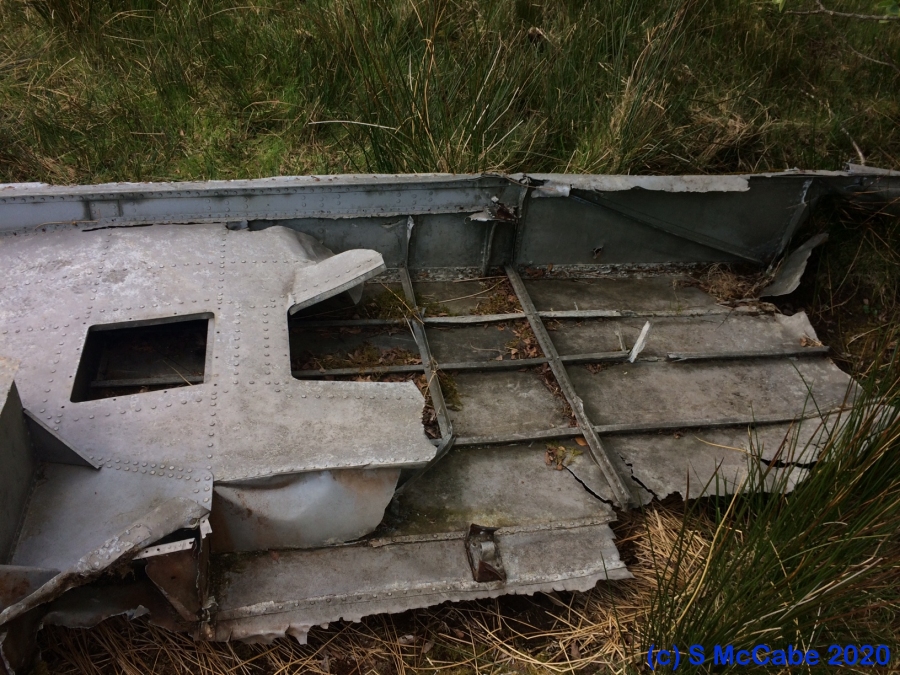
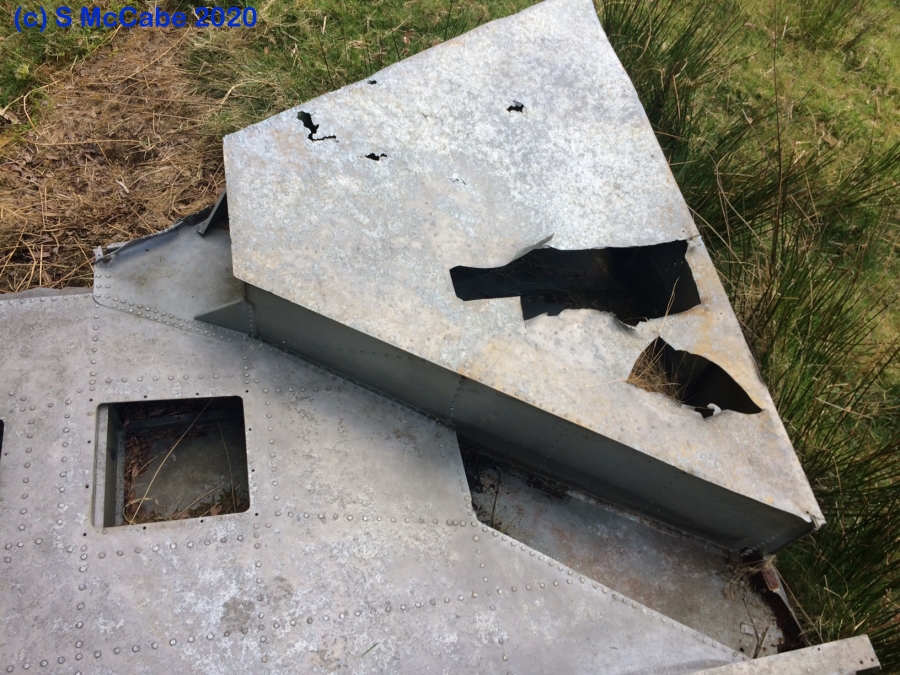
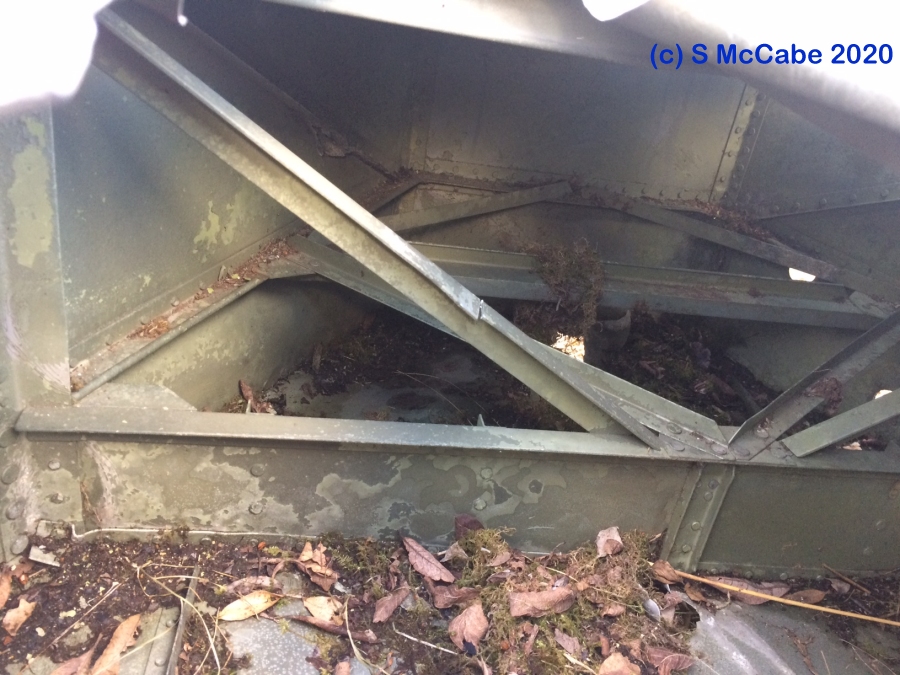
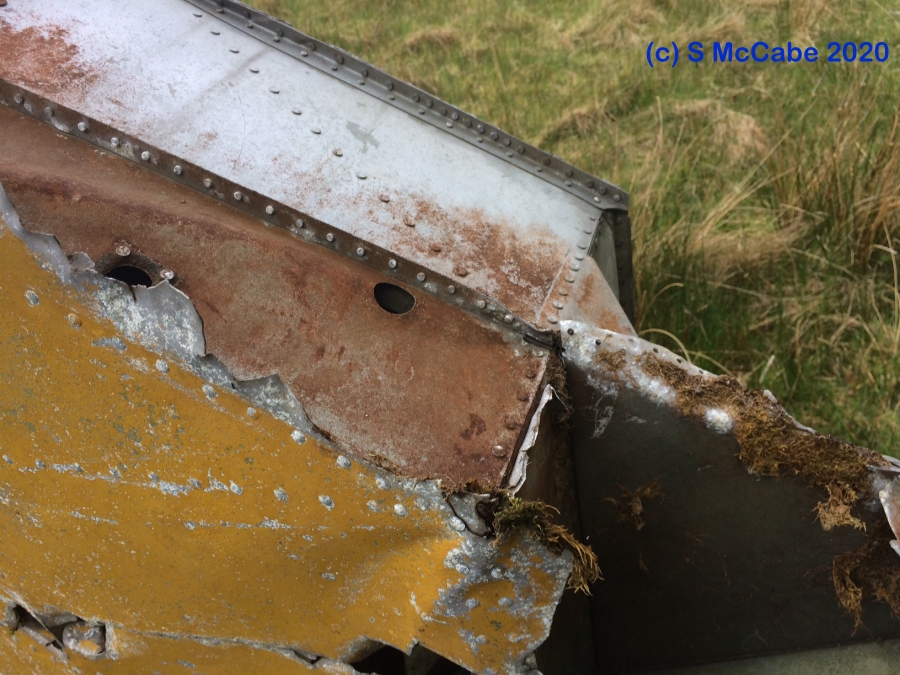
The upper surface of the section reveals the yellow paint
associated with the aircraft's original customer, the pre war
United States Navy.
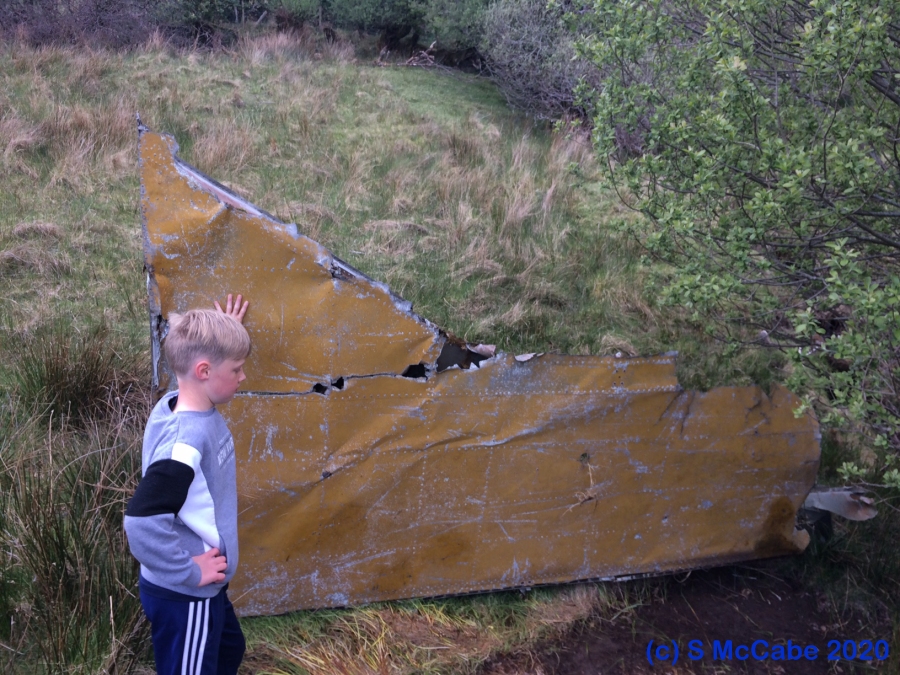
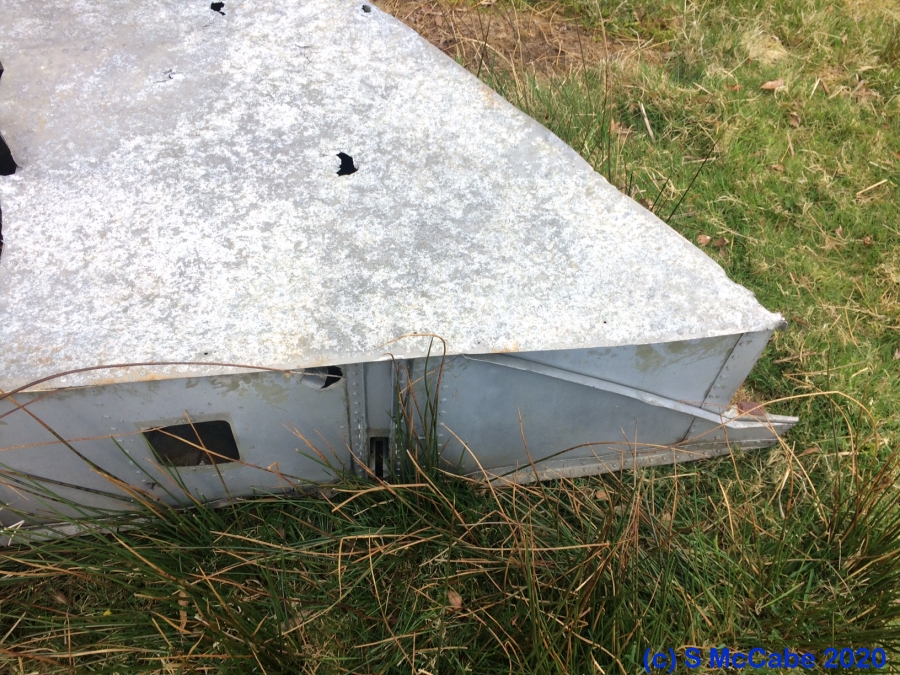
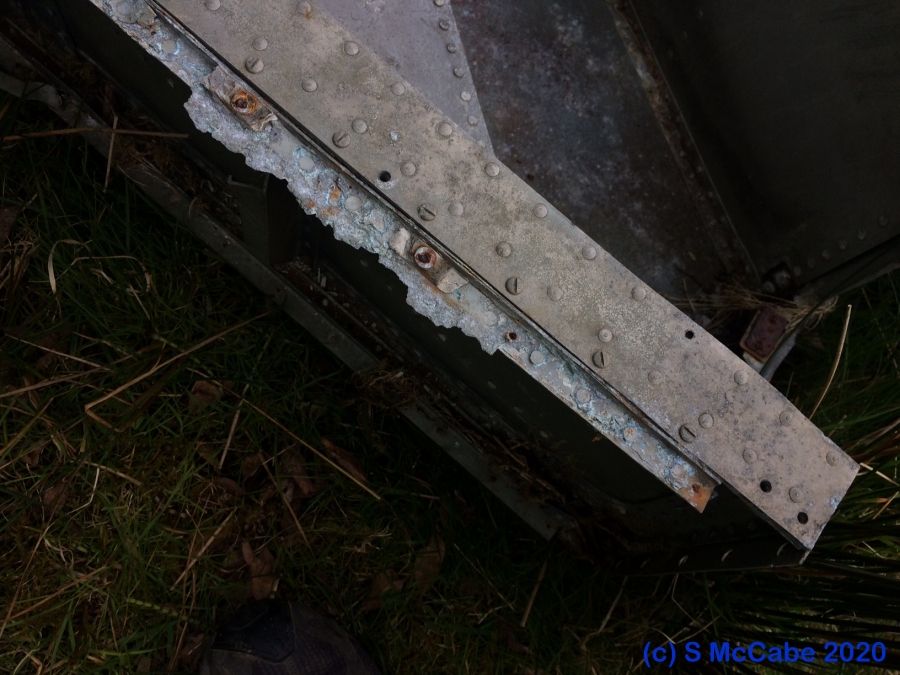
At some distance from the crash site then one can find this
animal shelter made using a large section of a wing.
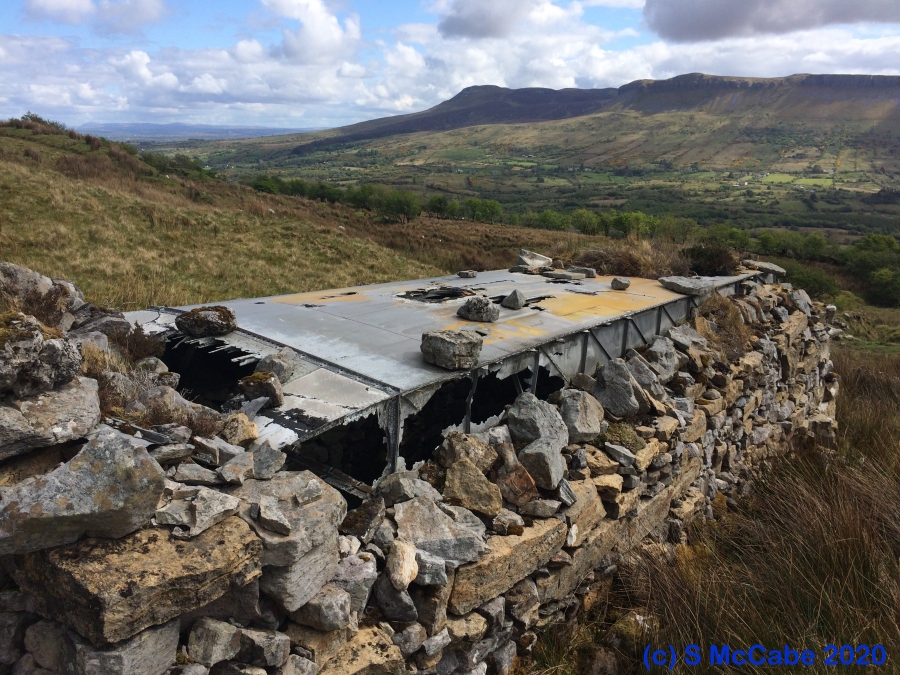
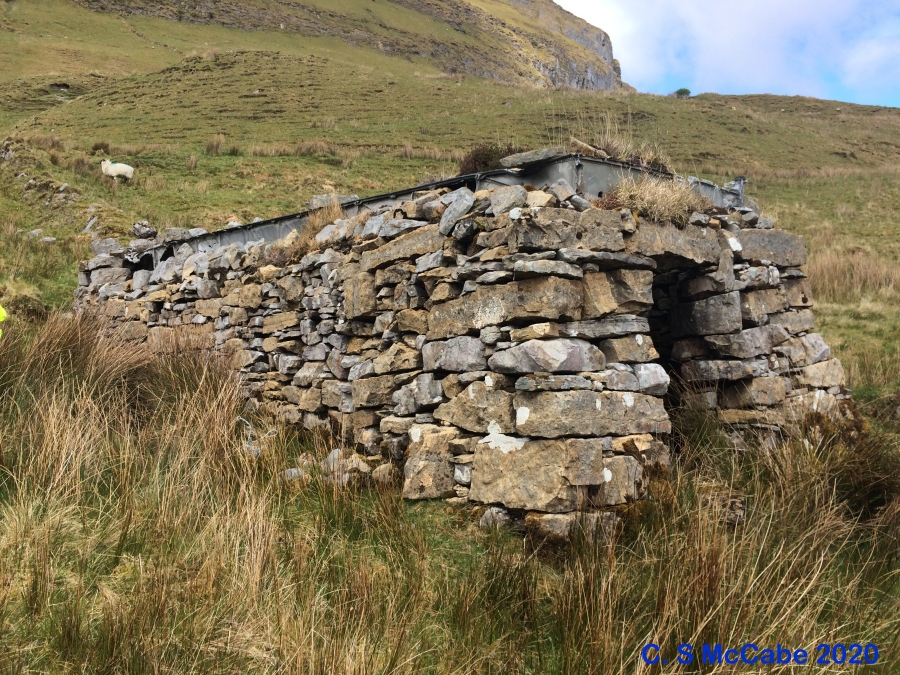
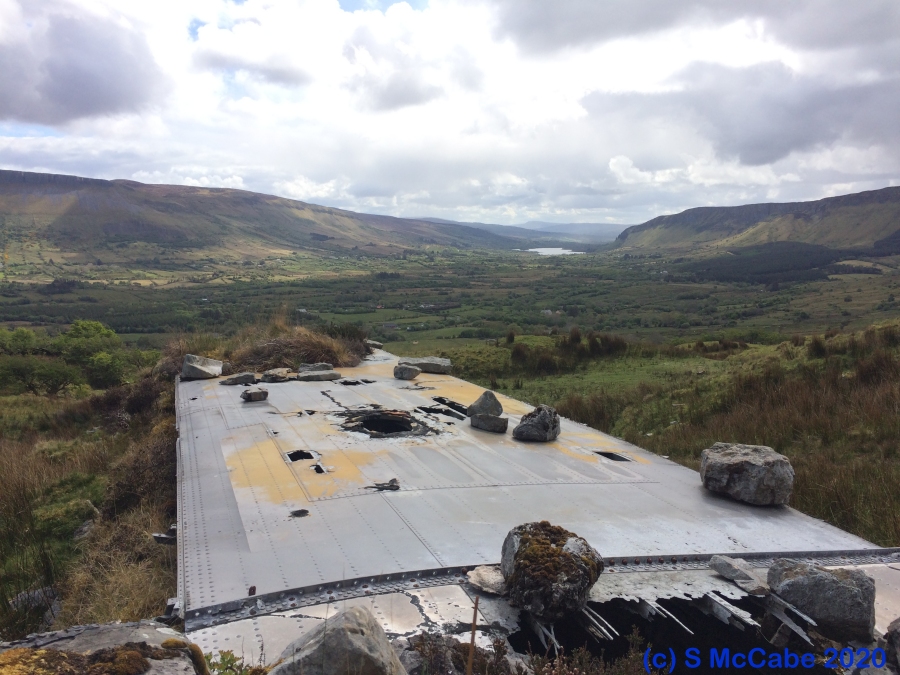
Compiled by Dennis Burke, July 2020, Dublin and Sligo. A great amount of credit must go to young James McCabe for his wreck hunting skills, as well as his dad Simon and brothers. Massive thanks to the niece and nephew of F R A Chalk, and Ronald Oldfields sister and brother in law, the family of H Dunbar and the family of H H Newbury, If you have information on any of the people listed above, please contact me at dp_burke@yahoo.com
